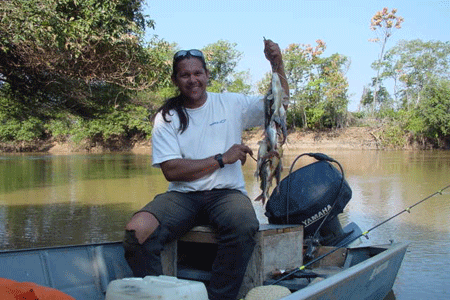
HONESTY, PROFESSIONALISM AND FRIENDSHIP MAKE THE DIFFERENCE.
Pantanal Wetlands
The Pantanal is the biggest floodable land with the biggest bio-diversity of South America, also considered an important biosphere reserve.
The localization of the Pantanal is fundamental for the ecosystem formation. The variety of vegetal species is huge because the Pantanal links to the Brazilian Savannah, flooded lands and also some types of Amazon vegetation.
The total area is around 240,000 square kilometers and is situated in Brazil, Bolivia and Paraguay. In Brazil the Pantanal is situated in the states of Mato Grosso (MT) and Mato Grosso do Sul (MS).
Cuiabá: Northern gateway to the Pantanal
Cuiabá is located in the state of Mato Grosso, approximately 1600 km. (1200 miles) from São Paulo. Starting from Cuiabá, it takes just 100 km. (62 miles) to reach the Pantanal, which starts in Poconé. If you travel by plane, Cuiabá is the nearest city to the Pantanal with an airport for domestic flights.
Pantanal flora
The Pantanal has a very rich flora, formed by plants from Cerrado (savanna), Amazon and Chaco (wetland). The vegetation is mainly varied because of the flood, the sandy and poor soil. During the dry season the fields, where the grassy plants predominate, become yellowish. Its vegetation is not homogeneous and the flora changes according to the elevation.
In the 'baías' there are aquatic plants floating or under water. The aguapés (lillypad) are very common in permanent waters or rivers with very low stream, forming a green carpet over the water. On the higher lands, where there is no flood, it is possible to find a typical cerrado and cerradão (where the higher trees are).
Pantanal fauna
The great variety of the ecosystem is also responsible for a high diversity of animals. The Pantanal fauna is very wealthy in birds, mammals, fishes, reptiles and insects. Capybaras, the biggest rodent in the world and caimans are easily seen.
In the Pantanal some endangered species like the giant river otter, the hyacinth macaw and the jaguar still can be found in in the wild. Pantanal Trackers offer special jaguar tracking tours when you search the isolated areas of the Pantanal where jaguars are often seen.
The Pantanal area is one of the most important places for water birds in the world. Serving as a 'nursery' for many species of birds. Nesting together in big trees to protect themselves against predators.
Seasons in the Pantanal
There are two seasons in the Pantanal, a rain season and a dry season. Nowadays it's difficult to precise when the rain season starts and ends.
Pantaneiros - people of the Pantanal
Though most Pantanal land is privately owned, not many people actually live in the Pantanal. The people of the Pantanal are known as 'Pantaneiros'. The main economic activity is cattle-ranching. Pantanal cowboys (peões) have their own typical food, clothing and equipment.
Seasons in the Pantanal
Rain season
In general we can say that the rain season starts in November and ends in April. At this time the water level raises and covers a large part of the land giving you the possibility to explore the waterways, revealing fantastic landscape views. The rain season is also the breeding season for most of the animals, when they search for higher lands to hide.
Dry season
In the dry season (May to October) the water level goes down forming baias (bays), lakes and waterways. It is the season when trees start to bloom and animals come out to look for food for their new born: mammals, reptiles and birds. As the land gets dryer they gather around the baias, lakes and waterways looking for water, giving you the chance to spot a variety of species.
The Pantanal







